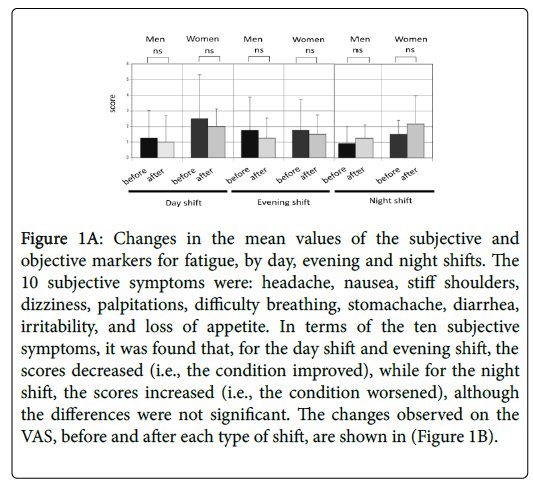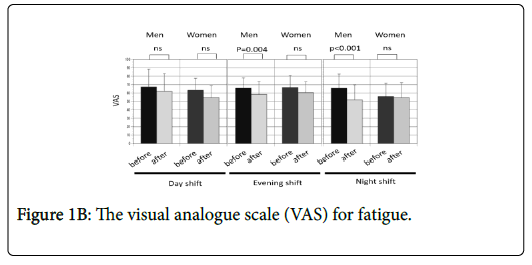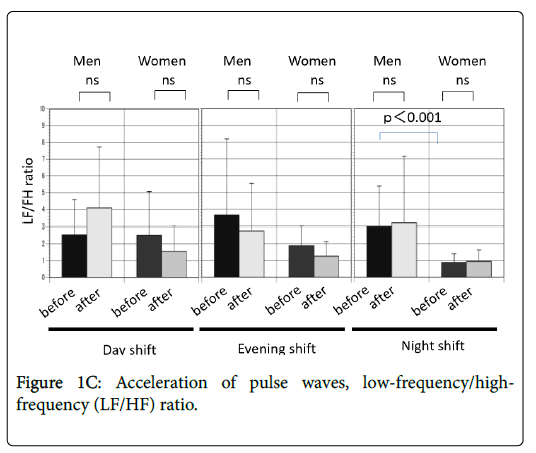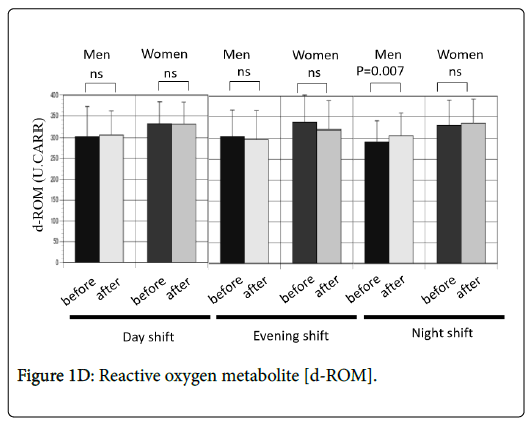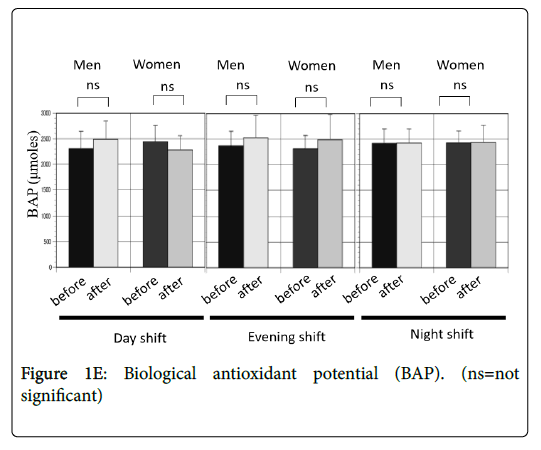Gender Differences in the Subjective and Objective Markers for Fatigue Associated with Shift Work: A Pilot Study
Received: 09-Feb-2018 / Accepted Date: 14-Feb-2018 / Published Date: 26-Feb-2018 DOI: 10.4172/2329-6879.1000272
Abstract
Purpose: This study investigated if there were differences between men and women, in the indices of fatigue, as a result of shift work.
Participants and methods: The participants were 24 nurses (12 men and 12 women), who were performing shift work at a hospital; they were matched by age, working hours and workplace. A self-administered survey was distributed, which included a set of questionnaires on the subjective symptoms and visual analogue scale [VAS] scores for fatigue. In addition, physiological tests (acceleration of pulse waves) and blood tests (reactive oxygen metabolite [d-ROM]; and biological antioxidant potential [BAP] were conducted before and after each of the three different shifts.
Results: The subjective symptoms improved after the day and evening shifts, but worsened after the night shifts. For the VAS, the scores decreased after all the shifts; for the night shifts, the changes in the scores in the men were significantly greater than those observed in the women (p=0.001). On comparing the before and after-shift values of the three different shifts, no significant differences were observed for the evening or night shifts, in terms of the acceleration of pulse waves, d-ROM, or BAP. For the acceleration of pulse waves for the day shift, the values were elevated after the shift for men, while it decreased for women. Similarly, the results before and after the work shifts, in terms of BAP, were 184.9 ± 281.9 μmol/L for men and -160.4 ± 307.5 μmol/L for women, showing an increase in the men and a decrease in the women, after the shifts. However, there was no significant gender difference, in terms of the d-ROM.
Conclusion: Gender differences were observed in the objective fatigue indicators, in spite of the fact that the mean age of both the men and women was the same and their workplace was the same. It is necessary to conduct future studies to clear support issues for shift working by gender.
Keywords: Gender difference; Biomarker; Fatigue; Shift work
Introduction
Shift work is associated with the increased prevalence of disorders of sleep, mood, and cognition [1]. The prevalence of most of these disorders is higher in women than in men [2]. However, few studies have investigated gender differences in the physiological response to shift work [3]. It has been reported that shift work causes disturbances in the secretion of cortisol; cortisol levels indicate the functioning of the autonomic nervous system, which controls the sleep rhythm, body temperature, pulse, and diurnal variation of cortisol [4].
Regardless of the length of time spent working, or the stress associated with psychologically demanding work, studies show that working night shifts affects the diurnal cortisol rhythm, and that there are differences between men and women, in this regard [5,6]. Therefore, it is necessary to consider gender differences in caring for individuals performing shift work.
Most assessments of fatigue rely on self-administered questionnaires centering on feelings of fatigue. A method generally used to assess fatigue is the visual analogue scale (VAS), which is commonly used to measure pain. However, it is associated with a great deal of individual variation, and like other self-administered questionnaires, lacks objectivity. There is reason to believe that objective indicators such as the acceleration of pulse waves and antioxidant potential could be used to identify fatigue [7-12].
In physiological fields, autonomic nervous function has historically been measured using frequency analyses such as fast Fourier transformation for the variation coefficient, and electrocardiograms for chronological R-R data. Takada et al. developed a method to measure autonomic nervous function using finger plethysmography [11]. Oxidative stress, measured by diacron reactive oxygen metabolite (d- ROM), is assessed by measuring the radical concentration that occurs when the iron in serum proteins is ionized, while biological antioxidant potential (BAP) is assessed by the ability of antioxidants in a sample to deoxidize into ferrous ions [9]. This suggests that measures such as oxidative stress and BAP could be used as objective indicators of fatigue [12,13].
Therefore, in this study, we matched participants, by age, working hours, workplace, and work duties. Then, we tested each indicator, before and after the day, evening, and night shifts, and examined if there were any differences between the men and women, in this regard.
Participants and Methods
The aims and methods of the study were explained at the target hospital, both through a speech and in writing. This study was conducted with the approval of the ethics board of the Japan Labor Health and Welfare Organization, and the written consent of the participants. The participants comprised 24 nurses (12 men and 12 women), performing shift work. Their age (years), working hours and workplace were matched. The study period was January 2015 to March 2015.
Measurement methods
The hospital has a three-shift system, consisting of a day shift (9:00– 17:00), evening shift (17:00–1:00), and night shift (1:00–9:00). The shift schedule was irregular, but participants were tested on the first day of the evening and night shifts, and on the first or second day of the day shifts, within one hour of the start and end of their shifts. As for the order of the tests, in general, the questionnaires were filled out first; this was followed by the drawing of blood, and the testing ended with the measurement of the acceleration of pulse waves [14].
Subjective assessments
Questionnaire surveys were conducted to evaluate subjective symptoms, lifestyle, and VAS scores. The ten subjective symptoms were: headache, nausea, stiff shoulders, dizziness, palpitations, difficulty breathing, stomachache, diarrhea, irritability, and loss of appetite, and they were rated on a three-point scale (0,1 and 2). The total number of points was used for the analysis. In the VAS for fatigue, participants were asked to score their subjective symptoms of fatigue, at the time of the survey, on a scale of 0 (the highest level of fatigue) to 100 (no feelings of fatigue).
Objective assessments
For this study, Artett (U-Medica, Ltd, Osaka, Japan) was used for the acceleration of pulse waves, which were measured for 3 minutes in a seated position after a 5-minute period of seated rest. The derivatives of finger plethysmograms are said to display similar physiological significance for a-a intervals for accelerated pulse waves, and R-R intervals for electrocardiograms [10].
Frequency analyses of the R-R intervals of electrocardiograms have revealed that low frequencies (LF) of up to 0.15 Hz primarily point to the activity of the sympathetic nerves (and also include some parasympathetic nerves), while high frequencies (HF) of over 0.15 Hz point to the activity of the parasympathetic nerves; thus, the ratio of the low-frequency and high-frequency components (LH/HF ratio) shows the balance of the autonomic nerves [11]. A high LH/HF indicates that the sympathetic nervous system is in a dominant position, and that an individual is in a state of fatigue.
Immediately following the drawing of blood, the d-ROM and the BAP were measured by separating the serum through centrifugation, using FREE Carrio Duo (Diacron International, Italy). It is known that d-ROM causes a phenton reaction when the iron in serum proteins is ionized, and all the oxidative metabolites in the serum sample (mainly hydroxy peptides) are replaced with alkoxyl radicals or peroxy radicals. The oxidative stress levels in the body can be assessed using the color reaction obtained on using a chromogen (aromatic alkylamine), to quantify the concentrations of the radicals produced. The unit used to measure the concentration of the various types of hydroperoxides in the blood was U.CARR (where 1U.CARR is equivalent to 0.08 mg/100 ml H2O2) [13-16]. BAP assesses the body’s antioxidant potential (it calculates how many μ moles of ferric ions the plasma deoxidized) by measuring the ability of the antioxidants in a sample to deoxidize the ferric ions, that have bound with the thiocyanate which is present in measuring reagents, into ferrous ions [16].
Statistical analysis
Comparison of the extraneous factors between men and women was conducted using independent t-tests, Mann-Whitney U tests, and chisquared tests. Changes in the indices were determined by a paired ttest. Differences in the variation of the values between men and women were determined by repeated measurement through analysis of variance (the general linear model option of SPSS). A P=value <0.05 was considered statistically significant, and multiplicity was considered by Bonferroni’s correction method. All statistical analyses were performed using SPSS ver. 22.0 software (IBM-SPSS, Tokyo, Japan).
Results
The comparison of the participants’ extraneous factors is shown in Table 1. The mean age of the male participants was 28.3 ± 7.0 years, and that of the women was 27.5 ± 5.7 years. The body mass index (BMI) was 23.7 ± 4.1 kg/m2 for men and 21.6 ± 2.2 kg/m2 for women. There was no significant difference between the two groups, in terms of either age or BMI. The amount of time (minutes/week) spent on exercise was significantly higher for men (67.5 ± 57.4) than women (12.5 ± 29.9).
| Men (n=12) | Women (n=12) | p | |||||
|---|---|---|---|---|---|---|---|
| Age | mean (SD) | 28.3 | 7 | 27.5 | 5.7 | 0.777 | |
| BMI | mean (SD) | 23.7 | 4.1 | 21.7 | 2.2 | 0.139 | |
| Communicate time | (minute/day) | mean (SD) | 21.7 | 18.7 | 36.8 | 26.4 | 0.199 |
| Sleep time | (hour/day) | mean (SD) | 6.2 | 0.94 | 5.7 | 0.78 | 0.139 |
| Exercise time | (minute/day) | mean (SD) | 67.5 | 57.4 | 12.5 | 29.9 | 0.007 |
| VDT time | (hour/day) | mean (SD) | 3.3 | 1.4 | 2.1 | 2.7 | 0.052 |
| Smoking time | Never | 9 | 11 | 0.465 | |||
| Ex- | 2 | 1 | |||||
| Current | 1 | 0 | |||||
| Drinking | Non | 8 | 9 | 0.52 | |||
Table 1: Background characteristics of participants.
The changes in the subjective symptoms, before and after each type of shift, are shown in (Figure 1A and 1B).
Figure 1A: Changes in the mean values of the subjective and objective markers for fatigue, by day, evening and night shifts. The 10 subjective symptoms were: headache, nausea, stiff shoulders, dizziness, palpitations, difficulty breathing, stomachache, diarrhea, irritability, and loss of appetite. In terms of the ten subjective symptoms, it was found that, for the day shift and evening shift, the scores decreased (i.e., the condition improved), while for the night shift, the scores increased (i.e., the condition worsened), although the differences were not significant. The changes observed on the VAS, before and after each type of shift, are shown in (Figure 1B).
On the VAS, the scores decreased after all the shift types; in men, particularly, the VAS scores significantly decreased in the case of both the evening and night shifts. Changes in the ratio of low frequencies and high frequencies (LF/HF ratio) for the acceleration of pulse waves, before and after each type of shift, are shown in (Figure 1C).
No significant differences were found before or after the evening or night shifts. As shown in (Figure 1D), no significant difference, between men and women, was found before and after each type of shift, for d-ROM, except in the case of the night shifts, in men. The d- ROM value, in men, significantly increased after the night shift.
As shown in (Figure 1E), in the case of BAP, the p value of the difference, before and after the day shift, was 0.044 in men; however, this was not significant, due to multiplicity correction (the alpha error was considered as 0.05/6).
Gender differences in the value before each shift work were observed only in the LF/HF ratio, in the night shift. The LF/HF ratio for the acceleration of pulse waves before the night shifts was significantly (p<0.0001) higher for men.
Table 2 shows the gender differences in the changes of each value, before and after each shift. There were no significant differences in the subjective symptoms, between the men and women [15]. However, in terms of the VAS values, the change in the men was significantly (p=0.012) greater than that in women (men -13.83 ± 8.47 vs. women -1.25 ± 13.51). In terms of the LF/HF ratio, significant differences between the men and women were observed, for the day shift. The LF/HF ratio was 1.55 ± 2.51 for men and -0.95±1.69 for women. The LF/HF ratio increased for men after the day shift, but decreased for women. In a similar manner, the behavior of the BAP in the case of the day shift was significantly (p=0.009) different between the men and women; the differences before and after the day shift were 184.9 ± 281.9 μmol/L for men and -160.4 ± 307.5 μmol/L for women. The BAP increased for men after the day shift, but it decreased for women. As for the d-ROM, there was no significant difference between the men and women.
| Working Shifts | Men | Women | p* | |
| mean ± SD | mean ± SD | |||
| Subjective symptoms | Day shift | -0.25 ± 2.05 | -0.50 ± 2.06 | 0.769 |
| Evening shift | -0.50 ± 1.83 | -0.25 ± 1.35 | 0.708 | |
| Night shift | 0.33 ± 1.23 | 0.66 ± 1.66 | 0.583 | |
| VAS scale for fatigue | Day shift | -5.25 ± 21.68 | -8.75 ± 14.33 | 0.645 |
| Evening shift | -7.45 ± 6.94 | -6.25 ± 17.07 | 0.823 | |
| Night shift | -13.83 ± 8.47 | -1.25 ± 13.51 | 0.012 | |
| Acceleration of pulse wave: (LF/HF ratio) | Day shift | 1.55 ± 2.51 | -0.95 ± 1.69 | 0.009 |
| Evening shift | -0.88 ± 2.75 | -0.64 ± 1.31 | 0.783 | |
| Night shift | 0.23 ± 2.81 | 0.06 ± 0.51 | 0.840 | |
| dROM | Day shift | 4.33 ± 44.4 | -1.17 ± 23.5 | 0.78 |
| Evening shift | -7.58 ± 22.6 | -16.75 ± 37.4 | 0.475 | |
| Night shift | 15.25 ± 16.1 | 5.75 ± 16.73 | 0.171 | |
| BAP | Day shift | 184.9 ± 281.9 | -160.3 ± 307.5 | 0.009 |
| Evening shift | 155.1 ± 497.0 | 177.6 ± 435.5 | 0.907 | |
| Night shift | 6.85 ± 195.5 | 8.38 ± 271.7 | 0.988 | |
| VAS=Visual Analogue Scale LF/HF=Low Frequencies/High Frequencies dROM=Reactive Oxygen Metabolite BAP=Biological Antioxidant Potential *p value was calculated by repeated measurement of general linear model. |
||||
Table 2: Gender difference in changes of subjective and objective markeres for fatigue by three shifts working.
Discussion
This study considered gender differences in the factors affecting shift workers’ fatigue, using the VAS and biomarkers [17]. Differences between men and women were found not only in the subjective symptoms, but also in the objective indicators of fatigue, even though the mean age of both the groups was the same, as were the workplace and duties performed.
The subjective symptoms improved after the day and evening shifts, while they worsened after night shifts; no difference was found between the men and women, in this regard. Meanwhile, for the VAS, while the symptoms worsened after each type of shift, only the scores of the men, after the evening and night shifts, reached significance. In general, individuals are likely to feel tired after work. For this study, one possible reason for the differences between the subjective symptom scores and the VAS scores is that participants were asked to choose from a limited selection of 10 subjective symptoms; consequently, in cases where an applicable subjective symptom was not included in the list, the participants’ levels of fatigue may not have been adequately reflected. It is likely that the subjective symptom scores increased after the night shifts, because they involve working at unphysiological hours, leading to fatigue build-up. Therefore, as an overall indicator of fatigue, the VAS is suggested to be more accurate.
In terms of the VAS of the subjective symptoms, no differences were observed between the men and women, before and after the day and evening shifts; however, the symptoms were significantly worse for men after night shifts. Since night shifts involve working at unphysiological hours, it is likely that workers feel more fatigued. However, it is possible that women experience a weaker sense of the subjective symptoms than men. It has been reported that, in the case of shift work among nurses, disturbances in the diurnal cortisol secretion rhythms, after working a night shift until the middle of the night, the following day (unpublished data), are observed only in women. Therefore, it is possible that the subjective symptoms were less evident due to disturbances in the diurnal cortisol rhythms. The symptoms of the men worsened significantly, as measured by the VAS, after the evening and night shifts. However, there was no significant difference before and after the shifts, in the LF/HF ratios for accelerated pulse waves, thus deviating from the subjective symptoms. Previously conducted studies have also shown discrepancies between the measured values for subjective symptoms and accelerated pulse waves [11]; thus, it is important to adopt objective indicators to assess fatigue.
On comparing the LF/HF ratio for accelerated pulse waves, d-ROM, and BAP, for the men and women, before the start of their shifts, only the LF/HF ratio was significantly higher for men, before the night shift. This suggests that the men were already in a state of autonomic imbalance (relative sympathetic dominance) before work.
No differences in the LF/HF ratio were observed, between the men and women, before and after the evening and night shifts. However, a difference between the genders was observed, before and after the day shifts; men were in a sympathetic dominant mode after work, while women were in a relatively parasympathetic dominant mode. Using 3- methyoxy-4-hyrdroxyphenylglycol (sMHPG), which is the end product of noradrenaline, in saliva, Li et al. investigated the relationship between feelings of health and sympathetic nervous activity among a general population, and found that, when placed under the same stresses, men’s sympathetic nervous systems were activated, while this was not the case for women; in fact, for women, this was suppressed in some cases [18]. The results of the present study are in agreement with those findings. Compared to other shifts, the day shift involves higher performance rates of treatments, tests and surgeries; thus, the workload and stress of caring for patients is likely greater. In the present study, we paired men and women working in the same ward, and, as their duties were very similar, we were able observe that there were differences in their responses to stress. Additionally, in general, it is possible that work stress influences changes in men, before and after their shifts, while, for women, the influence of outsidework stresses cannot be discounted. Kudielka et al. reported that, when measuring stress through the cortisol levels in the saliva, gender differences were noted depending on the duties the participants were engaged in [19]. For men, the cortisol levels rose with the stress of taking achievement tests, in which they either felt a sense of competition or intellectual inferiority; for women, the stress of ostracism by peers (social rejection) led to an increase in the salivary cortisol levels. In addition, a 2010 study by Tosaka et al. showed that men’s stress was directly linked to work, while women experienced the most stress in their relationships with others [20]. Despite the bodily stress associated with working evening and night shifts, considering the stress of the duties a day shift entails, evening and nigh shifts should be less psychologically stressful. Moreover, a larger number of individuals work during the day, and, thus, it is possible that the stress of handling relationships with others plays a role in gender differences too. A study from the UK reported gender differences, in terms of the effects of night shifts on mental health [21]. According to the study, the levels of anxiety and depression increased among men, after more than 4 years of working night shifts, while, for women, the frequency of anxiety and depression increased after 2 or more years of performing shift work.
There was almost no change in the d-ROM values before and after each type of shift, and no difference was observed between the genders. In terms of BAP, a gender difference was observed before and after the day shifts, with the BAP of the men increasing and that of the women decreasing. This change was similar to that observed in the case of the LF/HF ratio. Based on the fact that there was no significant difference in the d-ROM values, before and after the day shifts, it is unlikely that participants experienced any sudden oxidative stress; yet, the antioxidant potential rose for men and declined for women. In terms of acute fatigue, it has been reported that, while oxidative stress temporarily increases, antioxidant potential also increases, which acts to control the exacerbation of oxidative stress [22]. However, in this study, a reaction in the antioxidant potential was observed only in the men. In the models of chronic (pathological) fatigue, even if the values for oxidative stress increase, those of antioxidant potential decrease. In this study, although the women’s oxidative stress did not increase, their antioxidant potential decreased, suggesting a difference in the reactions associated with the antioxidant potential between the men and women, even when their work duties were the same.
This study compared differences between men and women, in terms of the subjective symptoms and objective indicators of stress and fatigue, before and after three different work shifts. The VAS for fatigue showed a gender difference in terms of only the night shift, while in the case of the LF/HF ratio for accelerated pulse waves and BAP, differences between men and women were noted before and after only the day shift. Since a divergence was observed between the subjective symptoms and objective indicators, in the assessment of fatigue, future studies should not only include questionnaires, but also focus on objective indicators. Since differences in the level of fatigue, between men and women, have been observed among nurses working shifts, it is necessary to consider gender differences in matters of women’s employment support.
The largest limitation of the present study is that it was conducted among shift workers at a single hospital, and, the sample size was small. Therefore, it is possible that the regional characteristics or particularities of the hospital played a role. Nevertheless, it is important to note that differences were observed between men and women performing the same duties, not only in terms of subjective symptoms but also objective indicators. Thus, it is necessary to expand the occupational field in future studies.
Declarations
Ethics approval and consent to participate
This study was conducted with the approval of the ethics board of the Japan Labor Health and Welfare Organization, and with the written consent of the participants.
Consent for publication
Not applicable
Availability of data and material
Data sharing is not applicable to this article, as no datasets were generated or analyzed during the study.
Competing interests
There are no conflicts of interest to declare.
Funding
This study was conducted with support from the Japan Organization of Occupational Health and Society, which provides health support to workers, and is involved in research and development, in the context of jobs and gender.
Authors' contributions
HT and CE planned and played central roles in the research. HT conducted the research and acquired data. MT contributed to the data analysis and interpretation. All authors read and approved the final manuscript.
Acknowledgements
The authors are grateful to Ms. Handa for her kind help.
References
- Marquie JC, Tucker P, Folkard S, Gentil C, Ansiau D (2015) Chronic effects of shift work on cognition: Findings from the VISAT longitudinal study. Occup Environ Med 72:258–264.
- Li R, Singh M (2014). Sex differences in cognitive impairment and Alzheimer’s disease. Front Neuroendocrinol 35: 385–403.
- Nohara M, Kitagawa T, Shigetomi A, Kagawa J (2001) Problem of working women: Past research and future issues. Industrial Medical Reviews (2);119-129.
- Hirose T (2005) An Occupational Health Physician’s report on the Improvement in the Sleeping Condition of Night Shift Workers. Ind Health 43: 58-62.
- Thomas C, Hertzman C, Power C (2009) Night work, long working hours, psychosocial work stress and cortisol secretion in mid-life: evidence from a British birth cohort. Occup Environ Med 66: 824-831
- Miyauchi F, Kimura K, Hirano M, Yamoto M, Sekihara H, et al. (2012) Sex Difference in the Effects of Night Work on Plasma Concentration of Cortisol and Cortisone. Job Stress Res 19: 249-254.
- Takada M, Ebara T, Kamijima M (2010) Heart rate variability assessment in Japanese workers recovered from depressive disorders resulting from job stress: Measurements in the workplace. Int Arch Occup Environ Health 83: 521-529.
- Yamaguti K, Tajima S, Kuratsune H (2013) Autonomic dysfunction in chronic fatigue synd-ROMe. Adv neuroimmune boil 4: 281-289.
- Fukuda S, Nojima J, Motoki Y, Yamaguti K, Nakatomi Y, et al. (2016) A potential biomarker for fatigue: Oxidative stress and anti-oxidative activity. Biol Psychol 118: 88-93.
- Akselrod S, Gordon D, Madwed JB, Snidman NC, Shannon DC, et al. (1985) Hemodynamic regulation: Investigation by spectral analysis. Am J Physiol 249: H867-875.
- Takada M, Ebara T, Sakai Y (2008) The Acceleration plethysmography system as a new physiological technology for evaluation autonomic modulations. J Human Ergol 35: 1-5.
- Ebata C, Tatsuta H, Tatemichi M (2017) Potential objective biomarkers for fatigue among working women. J Occup Health 59: 286-291.
- Okawa N, Shibata J, Jibu T, Hirata M, Nagami M, et al. (2016) Objective assessment of fatigue in school teachers and staff. J Fatigue Science 11: 43-55.
- Pasquini A, Luchetti E, Marchetti V, Cardii G, Iorio FL (2008) Analytical performances of d-ROMs test and BAP test in canine plasma. Definition of the normal range in healthy Labrador dogs. Vet Res Commun 32: 137-143.
- Cesarone MR, Belcaro G, Carratelli M, Cornelli U (1999) A simple test to monitor oxidative stress. Int Angiol 18: 127-130.
- Trotti R, Carratelli M, Barbieri M (2002) Performance and clinical application of a new, fast method for the detection of hydroperoxides in serum. Panminerva Med 44: 37-40.
- Li GY, Ueki H, Yamamoto Y, Yamada S (2006) Association between the scores on the general health questionnaire-28 and the saliva levels of 3-methyoxy-4-hyrdroxyphenylglycol in normal volunteers. Biol Psychol 73: 209-211.
- Kudielka BM, Kirschbaum C (2005) Sex differences in HPA axis responses to stress: A review. Biol Psychol 69: 113-132.
- Tosaka M (2015) Transition of differences between men and women about awareness of stress during the recent two decades: Date from comparison of questionnaires at two different eras. Nihon Rinsho 73: 681-685.
- Bara AC, Arber S (2009) Working shift and mental health-finding from british household pane survey (1995-2005). Scand J Work Environ Health 35: 261-267.
- Fukuda S, Nojima J, Motoki Y, Yamaguti K, Nnakatani Y, et al. (2016) A potential biomarker for fatigue: Oxidative stress and anti-oxidative activity. Biol Psychol 118: 88-93.
Citation: Tatsuta H, Ebata H, Tatmeichi M (2018) Gender Differences in the Subjective and Objective Markers for Fatigue Associated with Shift Work: A Pilot Study. Occup Med Health Aff 6: 272. doi:10.4172/2329-6879.1000272 DOI: 10.4172/2329-6879.1000272
Copyright: © 2018 Tatemichi et al. This is an open-access article distributed under the terms of the Creative Commons Attribution License, which permits unrestricted use, distribution, and reproduction in any medium, provided the original author and source are credited.
Share This Article
Recommended Journals
Open Access Journals
Article Tools
Article Usage
- Total views: 4459
- [From(publication date): 0-2018 - Apr 26, 2025]
- Breakdown by view type
- HTML page views: 3579
- PDF downloads: 880

